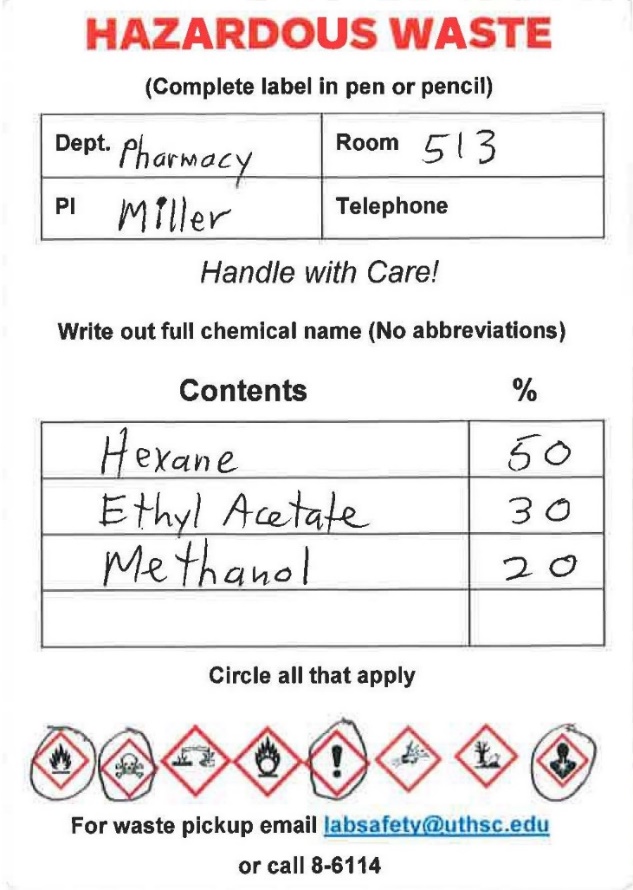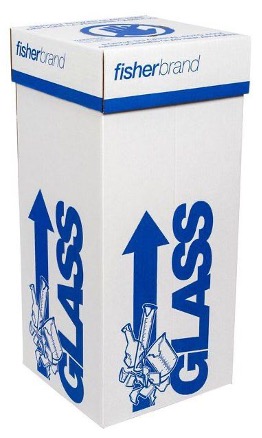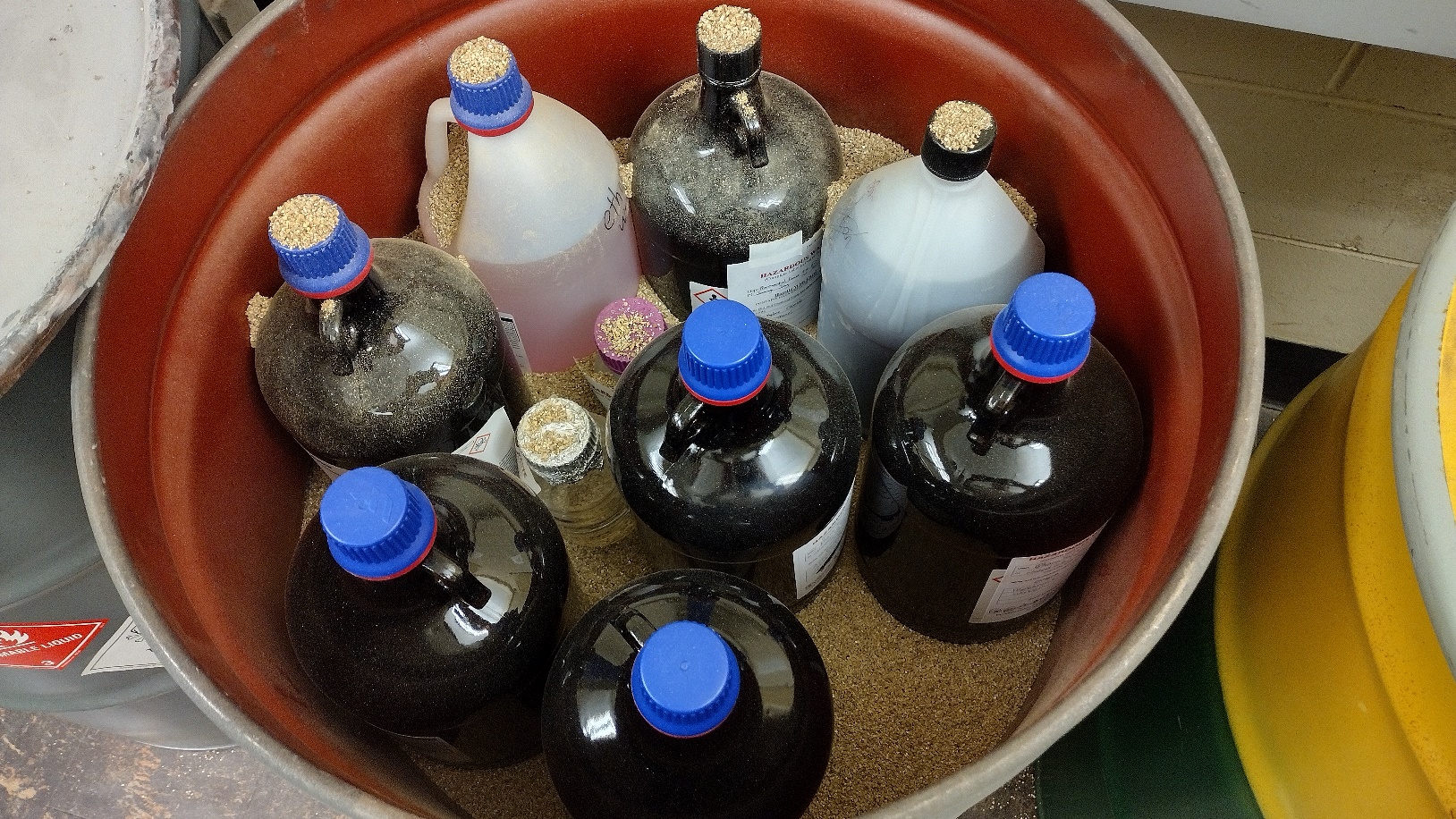Hazardous Chemical Waste
Hazardous Waste and Compliance Enforcement
Simply defined, hazardous waste is waste with properties that make it dangerous or capable of having a harmful effect on human health or the environment. The EPA and Tennessee Department of Environment & Conservation (TDEC) strictly enforce compliance. Violations can result in fines to the university.
Campus Responsibility
Ensuring the safety of our campus and compliance with environmental regulations is a collaborative effort.
Your Role: Whether you are a Principal Investigator (PI), Laboratory Manager, or supervisor, your vigilance in hazardous waste management is crucial.
Proper Disposal: It is forbidden to dispose of hazardous waste in drains or regular solid waste containers.
Unsure about disposal? Email safety@uthsc.edu for guidance.
Types of Campus Waste Regulated by EPA/TDEC (with examples)
Characteristic Hazardous Wastes:
- Ignitable (flammable solvents or gases, oxidizers)
- Corrosive (acids, bases)
- Reactive (cyanides, sulfides, alkali metals)
- Toxic (lead, chloroform)
Listed Hazardous Wastes:
- F-listed (spent solvents such as methanol or xylene)
- U-listed/P-listed (unused toxic commercial chemicals such as phenol or sodium azide)
Universal Wastes:
- Rechargeable batteries (Ni-Cd, Lithium Ion)
- Mercury-containing equipment (thermometers, thermostats)
- Lamps (fluorescent, metal halide)
- Aerosol cans
Mixed Hazardous Wastes:
Combination of hazardous chemicals with radioactive materials.
Biological wastes or solely radioactive wastes are not regulated as EPA hazardous waste.
Waste Determinations
To ensure correct characterization and disposal:
- Identify all chemical constituents within a hazardous waste container.
- Review Safety Data Sheets (SDSs) for information about chemical composition and hazardous properties.
- Consult PI, Laboratory Manager, supervisor, or the Office of Research Safety (safety@uthsc.edu) when unsure about composition.
If composition remains unknown, the Office of Research Safety may conduct additional analyses on the material.
Hazardous Waste Labeling

Hazardous Waste Label Example
The hazardous waste label is accessible here for printing.
Hazardous Waste Label Example
The hazardous waste label is accessible for printing.
Labeling is critical for safety and regulatory compliance. Download labels from the Office of Research Safety website (UTHSC Hazardous Waste Labels).
At Container Fill Start (as soon as waste enters a container):
- Mark as "Hazardous Waste" with an indication of the hazard of the contents (ignitable, corrosive, reactive, and/or toxic).
- List all chemical components in the waste. Do not use abbreviations, chemical formulas, or structures.
- Complete labels with approximate percentages (+/- 5% tolerance; "trace" for <1% components).
- Note department or building name, room number, and phone number on the label.
Unused material in the manufacturer’s original container can be submitted as waste without a hazardous waste label if the original label is still attached and legible.
If a chemical's composition is unknown, label it as “Hazardous Waste – awaiting proper characterization.”
Waste Storage Requirements and Best Practices
Waste containers must be kept where generated until pickup – do not leave in the hallway or other communal areas. Follow these practices to manage hazardous waste storage in a Satellite Accumulation Area (SAA).:
- Container Use: Store all waste in appropriate containers with a durable top that will stay closed (e.g., screw caps). Do NOT use biohazard bags.
- Headspace: Do not overfill waste containers. Leave an inch or two of head space in large liquid waste containers to allow for expansion due to temperature changes.
- Condition and Compatibility: Ensure containers are undamaged and suitable for their contents. Metal solvent cans must not be dented or rusted.
- Keep Closed: Only open containers when adding or removing waste.
- Labeling: All containers must be clearly labeled as soon as waste is first added to the container.
- Point of Generation Storage: Keep waste at or near where it is produced (same lab or room) under generator control. Secondary containment is required for waste liquids to prevent waste from entering drains.
- Volume Limitation: Do not exceed 55 gallons (or 1 quart/1 kg P-listed waste).
- Segregation by Compatibility: Separate chemicals based on compatibility (e.g., acids away from bases).
- Avoid Mixing Halogenated Wastes with non-halogenated ones in the same container.
- Prevent Reactions: Never mix incompatible wastes that could react.
- Separate Collection of acutely toxic or reactive substances to avoid high disposal costs.
Any spills should be addressed immediately, with clean-up materials managed as hazardous chemical waste.
Liquid Chromatography (LC) Waste: Ensuring EPA Compliance
Liquid chromatography (LC) is an essential analytical technique used widely within research fields. At UTHSC, High Performance Liquid Chromatography (HPLC) is the most common technique used in campus laboratories.
Organic Solvents and Regulations
Due to the common use of organic solvents like methanol and acetonitrile in LC procedures, most LC waste is classified as hazardous by the Environmental Protection Agency (EPA). Thus, managing this waste requires adherence to stringent regulations.
Proper Labeling and Storage
All containers collecting LC waste must be properly labeled. It is crucial to ensure that these containers remain closed during the operation of the LC unit to comply with safety standards. It is not acceptable to place a waste line directly into an open waste container or use materials such as foil or Parafilm® for closure purposes. These practices do not meet the regulatory definition of a closed container.
Improper LC Waste Collection Examples

Proper LC Waste Collection Examples

Campus Waste Disposal Pickup
Contact Campus Safety for removal of your chemical waste:
- Use the Waste Pickup Request feature of the EH&S Assistant (EHSA): EH&S Assistant | Research Safety Affairs | Office of Research | UTHSC
- Alternatively, email safety@uthsc.edu to request a pickup, including the building and room number(s). Specify the composition of each waste, the quantity, and the container size(s).
- For large disposals like lab cleanouts, email detailed lists/spreadsheets/photos to facilitate pickup procedures.
- Separate waste to be picked up from other chemicals and waste containers still in use.
Waste pickups usually occur within 1–3 business days.
Empty Container Management and Disposal

The EPA defines an empty container as one in which all hazardous waste has been removed using common practices (like pouring or pumping) and the residue does not exceed 3% by weight of the total capacity.
NOTE: Empty containers of unused EPA P-listed chemicals must be discarded as hazardous waste or triple-rinsed with a suitable solvent before being discarded, and the rinsate must be discarded as hazardous waste. (A complete list of EPA P-listed chemicals is in Appendix A of SOP HM5203).
Allow empty containers of volatile substances (e.g., solvents) to evaporate in a fume hood with the cap off before disposal to reduce staff exposure risks.
Do not leave empty glass bottles in hallways! Place empty glass containers in a broken glass box (pictured) or a sturdy box lined with a plastic trash bag. Do not exceed 20 pounds.
When ready for disposal, tape the box shut and label as “Glass Trash”. Contact your Housekeeping supervisor or submit a Custodial Services request using DASH to have the glass box picked up.
Waste Management
Waste picked up by Campus Safety is sorted by hazard classification and packed into drums for transport. UTHSC contracts with Treatment Storage and Disposal Facilities (TSDFs) to provide transportation, temporary storage, and final treatment or disposal for hazardous wastes. TSDFs can treat and dispose wastes from campus in the following ways:
- Energy Recovery: Flammable solvents and toxic liquids are blended with other compatible wastes and burned in a process that recovers the thermal energy from waste to reduce the use of natural resources, particularly in cement production.
- Elementary Neutralization: Acids and bases are neutralized and disposed as a non-hazardous liquid.
- Thermal Treatment: Oxidizers, reactive wastes, and acutely toxic wastes are destroyed by incineration.
- Recycling/Reclamation: Metals from universal wastes are recycled/reclaimed.

Hazardous Waste Information Links
The following links have more detailed information about hazardous chemical waste:
